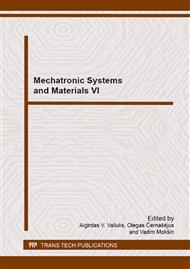p.684
p.693
p.698
p.703
p.708
p.714
p.720
p.725
p.731
The Use of Laser Texturing the Surface Layer to Modify the Friction Pair Pin-Bushing
Abstract:
This paper presents the methodology and results of laser texturing of the surface layer steel 41Cr4, applied to the manufacture of crankshafts and selected aluminum alloy used for the production of slide bearings (bearings) for internal combustion engines. Laser treatment of the surface layer of this material was carried out using Nd: YAG laser with a wavelength of pulsed laser radiation λ-1064 nm. Application of laser ablation micromachining in sensitive zones of the crankshaft and slide bearing, mainly the surface layer of the friction pair, was aimed to formation of a suitable surface texture containing oil microchannels. Applying different parameters ablative laser micromachining (power density, repetition rate, number of pulses in the same area, the overlap area microchannels), a very interesting stereometry of the surface layer steel 41Cr4 and bearing alloy was obtained. The lubricant had characteristic microchannels, very important in the tribological process of the friction pair crankshaft – slide bearing. Laboratory metallographic tests showed the high dispersion microstructure of martensitic steel 41Cr4 in the superficial zone, melted and hardened. The transition zone was found to be of martensitic-bainitic microstructure and bainite. The microstructures are formed by ultrafast phase transformations over time crystallization of alloy Fe-Cr-C from the liquid phase (microhardness in the range of 550-680 HV0.05). The microstructures appear in the adjacent area to the lubricant microchannels produced during laser texturing. The studies of laser texturing the sliding layer of slide bearing made of aluminum alloy, destined to cooperate with tribological function pin engine crankshaft are preliminary results. The positive results: high repeatability of the process texturing regular geometric shape microchannels and ease process control. In the best version, technological preliminary tests showed the following oil microchannels dimensions: depth of about 3.2 microns, width 47 microns; it is a promising result.
Info:
Periodical:
Pages:
708-713
Citation:
Online since:
January 2015
Authors:
Keywords:
Price:
Сopyright:
© 2015 Trans Tech Publications Ltd. All Rights Reserved
Share:
Citation:


